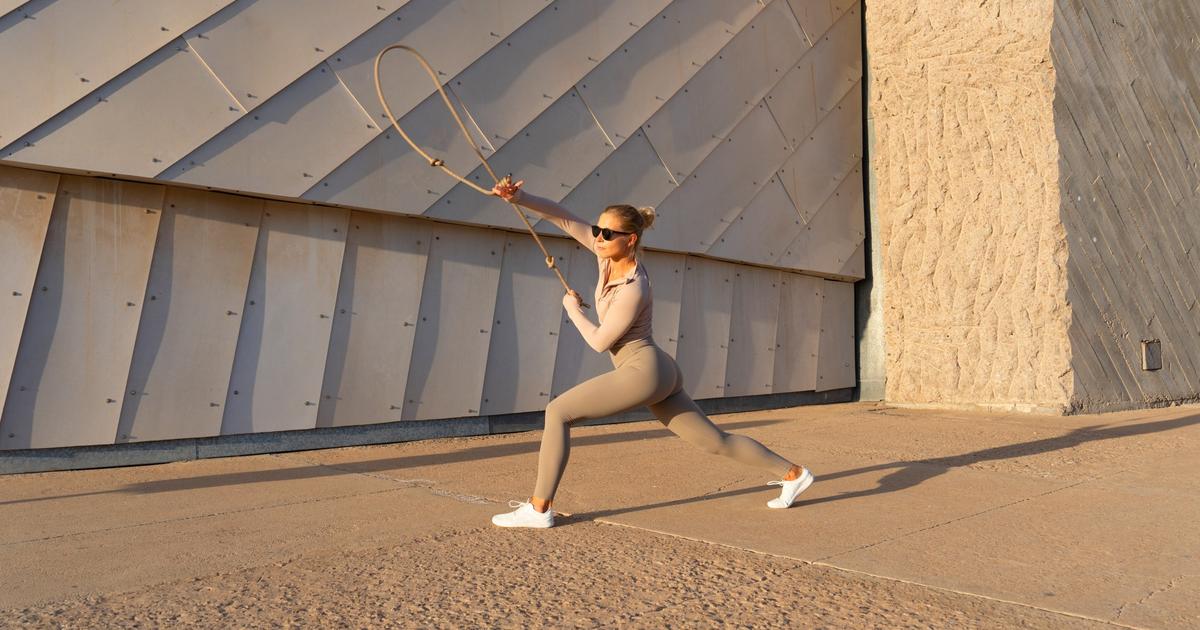If 28-year-old sports coach Georgina Igwe weren't wearing a lycra outfit, we'd almost mistake her for a cowgirl in this video posted to Instagram on Friday, September 9.
That afternoon, the young woman films herself spinning a rope above her head in a public garden in Paris.
A regressive hobby?
Not really.
Music in her ears, her hands tight on her "lasso", the sports coach draws curves in the air, oscillations, pivots in one direction, then in the other... Behind this complex and quite hypnotizing dance?
A practice called
"rope flow
", halfway between fitness and meditation.
Read alsoHula hoop, rollerblading, aerobics: how about building muscle while having fun?
In video, why it is good to sweat
Similarities with martial arts
The concept is simple: you swing a rope of about 500 g around you, without ever jumping.
More precisely, the gesture called
overhand
, consists in taking the rope by its two ends facing you then rotating it on each side of your sides.
Each loop should go from back to front and to accompany the transition from side to side, the hands draw the infinity symbol.
A second exercise, called
underhand,
consists of repeating this movement but this time in the opposite direction, from front to back.
“Once you have integrated the base, you have access to a multitude of possible combinations, assures coach Georgina Igwe.
The feet are well anchored in the ground, it's as if you were a tree whose branches move and bloom around.
This rather zen movement has similarities with martial arts, such as nunchaku, but in a softer way.
If the practice is still stammering in sports halls in France, it is already well established in the Philippines, the United Kingdom or the United States.
It was in the land of Uncle Sam that the technique emerged in the 2000s thanks to the training program of Californian coach David Weck, also inventor of the Bosu® (inflatable half-sphere).
Since 2019, other brands have taken it up to popularize it and offer online courses, such as the Lithuanian company Octomoves, which has a strong presence on Instagram, or the British company Way of Rope.
On social networks, the "rope flow" collects thousands of views, between tutorials and freestyle choreographies.
The benefits of rope flow
First, the practice is easy to access: it only takes a few sessions to take control of the rope, reassures coach Georgina Igwe.
Several models exist, in different colors and weights, and their cost varies on average between 18 and 70 euros.
"The ideal is to start with the lightest model possible for 10 to 15 minutes, with a rest period between each session, then gradually increase the duration of the sessions", suggests Lorris Gellé, osteopath and co-founder of the Anatomik center. .
We work primarily on the upper body.
Lorris Gellé, osteopath and co-founder of the Anatomik center
The specialist also knows very well the benefits of
“rope flow”
for having used it with his patients in his institute, one of whose addresses is located at the Wellness Galerie des Galeries Lafayette Paris Haussmann.
“Unlike bodybuilding, where we will target a particular area of the body, this rope will bring complete mobility, muscle and joint.
Above all, we work the upper body, the arms, the shoulders, the back but also the bottom, legs and abs-glutes, by sheathing and stabilizing the posture”, describes the osteopath.
After several sessions, there is no risk of looking like a doped weightlifter.
“The load of the rope remains very light, we will take little muscle mass, nuance sports doctor Victoria Tchaikovsky.
On the other hand, the prolonged effort will allow both to improve the cardiovascular system, the endurance to the effort but also to tone the whole body.
The
rope flow
can even be very interesting for a warm-up, before tennis or a boxing lesson.
The work will make it possible to improve the cardiovascular system, the endurance to the effort but also to tone the whole body.
Victoria Tchaikovsky, sports physician
The benefits don't stop there.
The activity requires coordination of complex movements and trains our brains to do double tasks, underlines osteopath Lorris Gellé.
This foolproof concentration allows you to reach a meditative state, testifies coach Georgina Igwe.
“We make a lot of mistakes, we whip ourselves very often, we learn all the time, she sums up.
It's a great lesson in patience and letting go!"
Contraindications
The
“rope-flow”
being intensive in terms of mobility, it is therefore strongly discouraged for people suffering from lumbago with fever, vertebral compression, sprains and tendon lesions, the specialists remind.
If you have the doctor's approval but you have lumbar, joint or muscle pain, you should not forget to opt for moderation, to protect yourself from pain, cervical tension and tendonitis.









